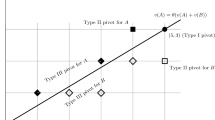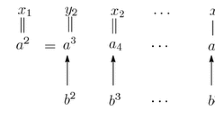Abstract
The Condorcet efficiency of a social choice procedure is usually defined as the probability that this procedure coincides with the majority winner (or majority ordering) in random samples, given a majority winner exists (or given the majority ordering is transitive). Consequently, it is in effect a conditional probability that two sample statistics coincide, given certain side conditions. We raise a different issue of Condorcet efficiencies: What is the probability that a social choice procedure applied to a sample matches with the majority preferences of the population from which the sample was drawn? We investigate the canonical case where the sample statistic is itself also majority rule and the samples are drawn from real world distributions gathered from national election surveys in Germany, France, and the United States. We relate the results to the existing literature on majority cycles and social homogeneity. We find that these samples rarely display majority cycles, whereas the probability that a sample misrepresents the majority preferences of the underlying population varies dramatically and always exceeds the probability that the sample displays cyclic majority preferences. Social homogeneity plays a fundamental role in the type of Condorcet efficiency investigated here.
Similar content being viewed by others
REFERENCES
Adams, J.R. and Adams, E.W. (2000), The geometry of voting cycles, Journal of Theoretical Politics 12, 131–153.
Balasko, Y. and Cres, H. (1997), The probability of Condorcet cycles and super majority rules. Journal of Economic Theory 75, 237–270.
Berelson, B., Lazarsfeld, P. and McGee, W. (1954), Voting. Chicago, IL: University of Chicago Press.
Black, D. (1948) On the rationale of group decision-making, Journal of Political Economy 56, 23–34.
Black, D. (1958), The Theory of Committees and Elections. London and New York: Cambridge University Press.
Brady, H.E. (1990), Dimensional analysis of ranking data, American Journal of Political Science 34(N4), 1017–1048.
Brady, H.E. and Ansolabehere, S. (1989), The nature of utility functions in mass publics, American Political Science Review 83(1), 143–163.
Chamberlin, J.R., Cohen, J.L. and Coombs, H.C. (1984), Social choice observed: Five presidential elections of the American Political Science Association, Journal of Politics 45, 479–502.
Cohen, L. (1979), Cyclic sets in multidimensional voting models, Journal of Economic Theory 20, 1–12.
Condorcet, Marquis de (1785), Essai sur l'Application de l'Analyse à la Probabilité des Décisions Rendues à la Pluralité des Voix.Paris.
Dobra, J.L. (1983), An approach to empirical studies of voting paradoxes: An update and extension, Public Choice 41, 241–250.
Dobra, J.L. and Tullock, G. (1981), An approach to empirical studies of voting paradoxes, Public Choice 36, 193–195.
Feld, S.L. and Grofman, B. (1986a), On the possibility of faithfully representative committees, American Political Science Review 80(3), 863–879.
Feld, S.L. and Grofman, B. (1986b), Partial single-peakedness: An extension and clarification, Public Choice 51, 71–80.
Feld, S.L. and Grofman, B. (1988), Ideological consistency as a collective phenomenon, American Political Science Review 82(3), 64–75.
Feld, S.L. and Grofman, B. (1990), Collectivities as actors, Rationality and Society 2(4), 429–448.
Feld, S.L. and Grofman, B. (1992), Who's afraid of the big bad cycle? Journal of Theoretical Politics 4(2), 231–237.
Garman, M.B. and Kamien, M.I. (1968), The paradox of voting: Probability calculations, Behavioral Science 13 (July), 306–317.
Gehrlein, W.V. (1997), Condorcet's paradox and the Condorcet efficiency of voting rules, Mathematica Japonica 45(1), 173–199.
Gehrlein, W.V. (1999), Condorcet efficiency of Borda rule under the dual culture condition, Social Science Research 28, 36–44.
Gehrlein, W.V. and Fishburn, P.C. (1976a), Condorcet's paradox and anonymous preference profiles, Public Choice 26 (Summer), 1–18.
Gehrlein, W.V. and Fishburn, P.C. (1976b), The probability of the paradox: A computable solution, Journal of Economic Theory 13 (August), 14–25.
Gehrlein, W.V. and Lepelley, D. (1999), Condorcet efficiencies under the maximal culture condition, Social Choice and Welfare 16, 471–490.
Gehrlein, W.V. and Lepelley, D. (2001), The Condorcet efficiency of Borda rule with anonymous voters, Mathematical Social Sciences 41(1), 39–50.
Gehrlein, W.V. and Valognes, F. (forthcoming), Condorcet efficiency: A preference for indifference, Social Choice and Welfare.
Grofman, B. (1975), A comment on democratic theory: A preliminary mathematical model, Public Choice 2l (Spring), 100–103.
Grofman, B. and Uhlaner, C. (1985), Metapreferences and reasons for stability in social choice: Thoughts on broadening and clarifying the debate Theory and Decision 19, 31–50.
Jones, B., Radcliff, B., Taber, C. and Timpone, R. (1995), Condorcet winners and the paradox of voting: probability calculations for weak preference orders. The American Political Science Review 89(1): 137–144.
Klahr, D. (1966), A computer simulation of the paradox of voting, American Political Science Review 60, 384–390.
Kurrild-Klitgard, P. (2001), An empirical example of the Condorcet paradox of voting for a large electorate, Public Choice, 107(1): 135–145.
Kuga, K. and Nugatani, H. (1974), Voter antagonism and the paradox of voting, Econometrica 14 (November), 1045–1067.
Lepelley, D., Pierron, P. and Valognes, F. (2000), Scoring rules, Condorcet efficiency and social homogeneity, Theory and Decision 49, 175–196.
Luce, R.D. (1956), Semiorders and a theory of utility discrimination, Econometrica 26, 178–191.
McKelvey, R.D. (1976), Intransitivities in multidimensional voting models and some implications for agenda control, Journal of Economic Theory 12, 472–482.
McKelvey, R.D. (1979), General conditions for global intransitivities in formal voting models, Econometrica 47, 1085–1112.
McKelvey, R.D. (1986), Covering dominance, and institution free properties of social choice, American Journal of Political Science 30, 283–314.
Miller, N.R., Grofman, B. and Feld, S.L. (1989), The geometry of majority rule, Journal of Theoretical Politics 1, 379–406.
Niemi, R. (1969), Majority decision-making with partial unidimensionality, American Political Science Review 63 (June), 488–497.
Niemi, R. (1970), The occurrence of the paradox of voting in a university election, Public Choice 8, 91–100.
Niemi, R. (1983), Why so much stability? Another opinion, Public Choice 41(2), 261–270.
Niemi, R. and Weisberg, H.F. (1968), A mathematical solution for the probability of the paradox of voting Behavioral Science 13 (July), 317–323.
Niemi, R. and Wright, J.R. (1987), Voting cycles and the structure of individual preferences Social Choice and Welfare 4, 73–183.
Norpoth, H. (1979), The parties come to order! Dimensions of preferential choice in the West German Electorate, 1961–1976, American Political Science Review 73(3), 724–736.
Pierce, R. (1996), French Presidential Elections Survey, 1988 (computer file). ICPSR version. Ann Arbor, MI: Roy Pierce, University of Michigan (producer), 1995. Ann Arbor, MI: Inter-University Consortium for Political and Social Research, 1996.
Radcliff, B. (1997), Collective preferences in presidential elections, Electoral Studies 13, 50–57.
Regenwetter, M., Falmagne, J.-C. and Grofman, B. (1999), A stochastic model of preference change and its application to 1992 Presidential Election panel data, Psychological Review 106(2), 362–384.
Regenwetter, M. and Grofman, B. (1998a), Approval voting, Borda winners, and Condorcet winners: Evidence from seven elections, Management Science 44 (April), 520–533.
Regenwetter, M. and Grofman, B. (1998b), Choosing subsets: A size-independent probabilistic model and the quest for a social welfare order, Social Choice and Welfare 15(3), 423–443.
Riker, W. (1958), The paradox of voting and congressional rules for voting on amendments, American Political Science Review 52, 349–366.
Riker, W. (1982), Liberalism Against Populism: A Confrontation Between the Theory of Democracy and the Theory of Social Choice. San Francisco, CA: W.H. Freeman.
Saari, D. (1995), Basic Geometry of Voting. New York: Springer.
Schofield, N.J. (1978), Generic instability of majority rule, Review of Economic Studies 50, 695–705.
Schofield, N.J. (1995), Coalition politics: A formal model and empirical analysis, Journal of Theoretical Politics 7, 245–281.
Schofield, N.J., Grofman, B. and Feld, S.L. (1988), The core and the stability of group choice in spatial voting games, American Political Science Review 82(1), 195–211.
Sen, A.K. (1966), A possibility theorem on majority decisions, Econometrica 34, 491–499.
Sen, A.K. and Pattanaik, P. (1969), Necessary and sufficient conditions for rational choice under majority decision, Journal of Economic Theory 1, 178–202.
Shepsle, K.A. (1979), Institutional arrangements and equilibrium in multidimensional voting models, American Journal of Political Science 23, 27–59.
Shepsle, K.A. and Bonchek, M.S. (1997), Analyzing Politics: Rationality, Behavior and Institutions. New York: Norton.
Tanguiane, A.S. (1991), Aggregation and representation of preferences: Introduction to the mathematical theory of democracy, Berlin: Springer.
Tovey, C. (1990), The almost surely shrinking yolk, Working Paper. School of Industrial and Systems Engineering, Georgia Institute of Technology.
Tovey, C. (1992), The probability of an undominated central voter in 2-dimensional spatial majority voting, Social Choice And Welfare 9(1), 43–48.
Tovey, C. (1997) Probabilities of preferences and cycles with super majority rules, Journal of Economic Theory 75, 271–279.
Tsetlin, I. and Regenwetter, M. (in press.) On the probabilities of correct or incorrect majority preference relations, Social Choice and Welfare.
Tullock, G. (1981), Why so much stability? Public Choice 37(2), 189–202.
Van Deemen, A. (1999), The probability of the paradox of voting for weak preference orders, Social Choice and Welfare 16, 171–182.
Van Deemen, A. and Vergunst, N. (1998), Empirical evidence of paradoxes of voting in Dutch elections, Public Choice 97, 475–490.
Weissberg, R. (1978), Collective vs. dyadic representation, American Political Science Review 72 (June), 535–547.
Williamson, O. and Sargent, T.J. (1967), Social choice: A probabilistic approach, Economic Journal 77, 797–813.
Author information
Authors and Affiliations
Rights and permissions
About this article
Cite this article
Regenwetter, M., Adams, J. & Grofman, B. On the (Sample) Condorcet Efficiency of Majority Rule: An alternative view of majority cycles and social homogeneity. Theory and Decision 53, 153–186 (2002). https://doi.org/10.1023/A:1021215903030
Issue Date:
DOI: https://doi.org/10.1023/A:1021215903030




